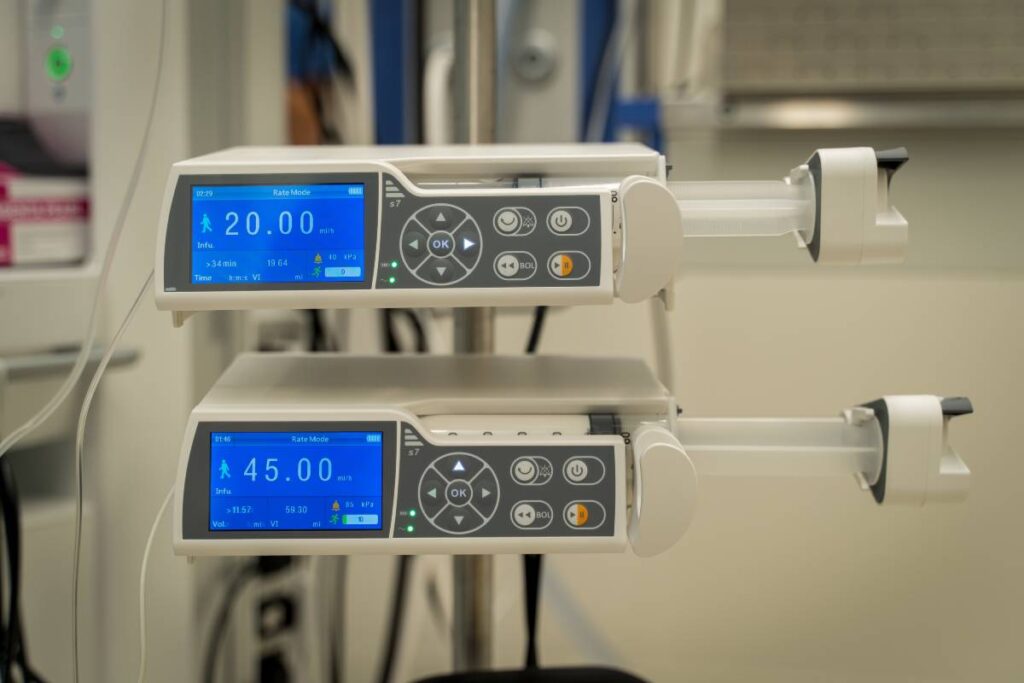Total intravenous anesthesia (TIVA) is a common general anesthesia technique in which anesthetic agents are given intravenously via a syringe pump, circumventing the use of inhalation agents. Frequently used alongside TIVA, target controlled infusion (TCI) is an algorithm-based, user-friendly method of guiding the clinician in the intravenous delivery of anesthesia 1. With or without the use of a TCI, TIVA is emerging as particularly useful across various clinical contexts, including in orthopedic surgery.
A 2014 review found that in patients undergoing ambulatory surgery, the maintenance of anesthesia with TIVA using propofol appeared not to impact the incidence of unplanned hospital admissions 2. This highlights the safety of TIVA in ambulatory surgery.
A 2016 prospective randomized clinical trial in dogs compared TIVA with propofol to isoflurane, an inhalation anesthetic, for maintaining hemodynamic stability and an appropriate depth of anesthesia during orthopedic surgery. Researchers measured the total number of anesthetic interventions required to treat cardiovascular depression or arousal/movement episodes in dogs under intrathecal and general anesthesia 3. Despite no differences during surgery, more interventions were required in the propofol-based TIVA group preoperatively . Although further research is needed to determine whether these veterinary findings also apply to the human clinical setting, these data suggest some limitations of TIVA in the context of orthopedic surgery.
Another veterinary research study from 2018 revealed that propofol TIVA, in combination with epidural anesthesia, improved mean arterial pressure, thereby acting as a viable alternative to isoflurane in the context of orthopedic surgery on healthy dogs 4. However, since it was found to be associated with increased respiratory depression, mechanical ventilation needs to be readily available.
Most recently, a 2020 study confirmed that both TIVA and balanced anesthesia are equivalent in terms of the stability of the depth of anesthesia induced 5. However, since individual physiology might make a difference, it remains important to keep testing factors that could affect outcomes across clinical populations.
In addition to being a cost-effective option, TIVA is well tolerated and simple 6. In comparison to traditional inhalation anesthesia, the use of TIVA via a TCI also reduces the incidence of postoperative nausea and vomiting 7, has no residual paralyses (whereas regional anesthesia techniques carry a risk of longer-than-intended muscle paralysis 6), and may result in better recovery and greater hemodynamic stability 8,9. Finally, TIVA-based anesthesia may minimize bradycardia and hypotensive episodes, as well as improve intubation conditions 10.
TIVA can be conducted either with a single drug or with a combination of drugs. The pharmacokinetic profiles of the drugs is important to consider during drug selection. The most commonly used groups of drugs include hypnotics and short-acting opioids 11. The discovery of propofol in the 1970s, however, revolutionized the clinical use of TIVA, and it currently remains the only intravenously active hypnotic agent suitable for the induction and maintenance of anesthesia. Propofol can be coupled with opioids, muscle relaxants, or non-steroidal anti-inflammatory drugs, depending on the patient or type of procedure.
Since TIVA is exclusively conducted via an intravenous infusion, either a peripheral or a central venous access device can be selected. This selection is often guided either by the patient’s condition, or by the number and types of drugs to be infused.
TIVA in itself does not help with post-operative pain management. However, if used in the context of a multimodal pain management approach, such as alongside regional anesthesia, continued analgesia may be provided.
Into the future, TIVA developments across clinical contexts, including for orthopedic surgery, will include the refinement of TCI methods, the introduction of new drugs or adjuvants, and improved effect monitoring 6.
References
1. Campbell, L., Engbers, F. H. & Kenny, G. N. C. Total intravenous anaesthesia. CPD Anaesthesia (2001). doi:10.1097/00001503-199108000-00010
2. Kumar, G., Stendall, C., Mistry, R., Gurusamy, K. & Walker, D. A comparison of total intravenous anaesthesia using propofol with sevoflurane or desflurane in ambulatory surgery: Systematic review and meta-analysis. Anaesthesia (2014). doi:10.1111/anae.12713
3. Sarotti, D., Rabozzi, R. & Franci, P. Impact evaluation of two different general anesthesia protocols (TIVA with propofol vs isoflurane) on the total number of interventions to treat cardiovascular depression or arousal/movement episodes in dogs undergoing orthopedic surgery receiving an intr. J. Vet. Med. Sci. (2016). doi:10.1292/jvms.15-0661
4. Bustamante, R., Aguado, D., Cediel, R., Gómez de Segura, I. A. & Canfrán, S. Clinical comparison of the effects of isoflurane or propofol anaesthesia on mean arterial blood pressure and ventilation in dogs undergoing orthopaedic surgery receiving epidural anaesthesia. Vet. J. (2018). doi:10.1016/j.tvjl.2018.01.002
5. Oliveros, H. et al. Variability of anesthetic depth in total intravenous anesthesia vs balanced anesthesia using entropy indices: A randomized, crossover, controlled clinical trial. Colomb. J. Anesthesiol. (2020). doi:10.1097/CJ9.0000000000000163
6. Eikaas, H. & Raeder, J. Total intravenous anaesthesia techniques for ambulatory surgery. Current Opinion in Anaesthesiology (2009). doi:10.1097/ACO.0b013e3283310f6b
7. Ozkose, Z. et al. Inhalation versus total intravenous anesthesia for lumbar disc herniation: Comparison of Hemodynamic Effects, Recovery Characteristics, and Cost. J. Neurosurg. Anesthesiol. (2001). doi:10.1097/00008506-200110000-00003
8. Lee, W. K., Kim, M. S., Kang, S. W., Kim, S. & Lee, J. R. Type of anaesthesia and patient quality of recovery: A randomized trial comparing propofol-remifentanil total i.v. anaesthesia with desflurane anaesthesia. Br. J. Anaesth. (2015). doi:10.1093/bja/aeu405
9. Wang, Y. et al. A randomized comparison of target-controlled infusion of remifentanil and propofol with desflurane and fentanyl for laryngeal surgery. ORL (2011). doi:10.1159/000322598
10. Godet, G., Watremez, C., El Kettani, C., Soriano, C. & Coriat, P. A comparison of sevoflurane, target-controlled infusion propofol, and propofol/isoflurane anesthesia in patients undergoing carotid surgery: A quality of anesthesia and recovery profile. Anesth. Analg. (2001). doi:10.1097/00000539-200109000-00007
11. Nora, F. S. Total Intravenous Anesthesia as a Target-Controlled Infusion . An Evolutive Analysis. Rev. Bras. Anestesiol. (2008). doi: 10.1590/s0034-70942008000200011.
